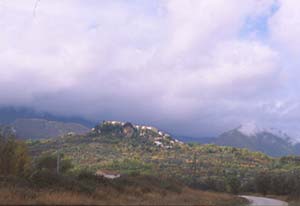![]() Fortifications
Fortifications
![]() Mountain fortifications
Mountain fortifications
The
Molisian landscape, which is mainly mountainous, is characterised by a large
number of naturally defensible fortifications located in positions of
considerable topographical eminence (Mount Ferrante, St. Mary dei Vignali,
Mount S.Croce, etc.). They were often built on mountaintops. Some of them date
back to very early periods (mainly Samnitic: Terravecchia di Sepino, Frosolone,
etc.) and were sometimes reused in the Roman period and in the Middle Ages.
They were called castellum vetus by the Normans, when the territory was
marked by a vast network of fortified structures. Enclosing walls and redoubts,
with flanking towers, salient curtain walls and bayonet doors were almost
always erected on mountaintops using polygonally cut local stone or large
rough-cut elements set in usually irregular rows. The remains of old fortified
burghs, often dating back to the 6th century when the settlements
in the lowlands and valleys were abandoned, were often reused.
In the Middle Ages, a large number of fortifications were built on the summit
of rocky outcrops (Pescolanciano, for example) or along the crest of ridges,
with the foundations lodged in carefully carved terraces. In some cases, it
has been established that considerable embankments were made to form platforms
and ramps (Roccamandolfi) protected by straight walls that sometimes surround
the entire rocky mass, by spurs and "rompitratta" walls or by more
rare “caisson” structures.
 |
Castel S. Vincenzo |